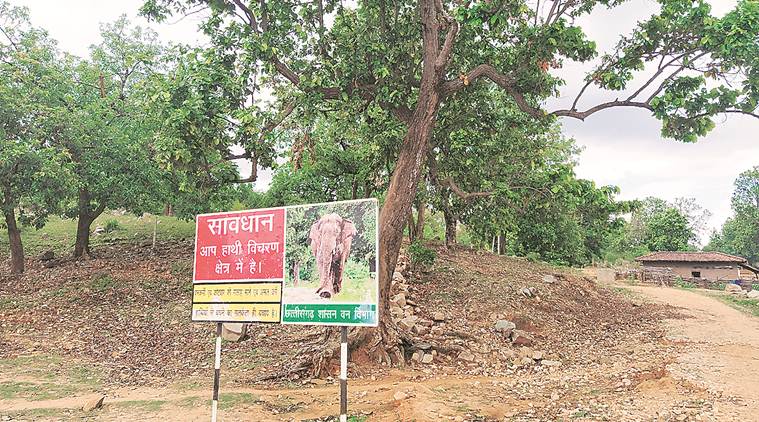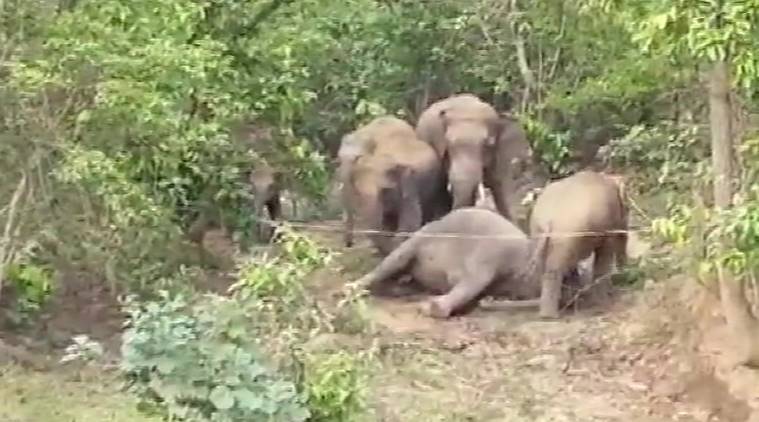 Villagers in Gopalpur say elephants visit more often now
Villagers in Gopalpur say elephants visit more often now
Three female elephants have been found dead in Surguja division over five days, prompting the state government to form an SIT and highlighting the human-elephant conflict in the division where more than 200 pachyderms jostle for space with villages extending into forests.
“On June 6, the first female elephant died in the forest near Khutantola, a small hamlet of Gopalpur panchayat (in Balrampur district). The herd then moved to the forest near Ganeshpur (of adjoining Surajpur district), where on June 8, a pregnant elephant, carrying nearly close to term, died. On June 9, another elephant collapsed while standing and died,” said Arun Dubey, Chhattisgarh Assistant Principal Chief Conservator, saying symptoms of toxicity were found in at least two of three animals.
The body of the elephant who died on June 6 was found on June 10 after villagers noticed a foul smell in the forest in Balrampur district. On Saturday, four forest officials in Balrampur were suspended for not being able to monitor the region properly.
According to Dubey, the animals had haemorrhaged intestines, organ failures and charred skin — signs of consumption of chemical toxins or fertilisers. “I saw bags of fertilisers under the body of the second animal,” Dubey said, adding that “it is possible that the animal ate the fertiliser in someone’s field or houses. Farmers do store a sack or two”.
 A Pregnant elephant was found dead in Chhattisgarh on Wednesday. (ANI)
A Pregnant elephant was found dead in Chhattisgarh on Wednesday. (ANI)
However, Balrampur divisional forest officer Pranay Mishra said the three deaths are not related. “In my understanding, if the source of toxicity between the first and the third elephant were the same, why would one collapse on June 6 and the other travel over 25 km and die three days later?”
Mishra said the animals didn’t consume anything harmful last week. “We have traced the animals’ path in our region and checked door to door.”
The state government has formed a five-member SIT under retired principal chief conservator of forests K C Bewarta, including wildlife experts, lawyers, doctors and APCCF Dubey, and the committee is expected to submit its report in a month. “We have sent viscera and blood samples to the labs in Bangalore, Jabalpur and other places. We have also sent samples to Raipur laboratory to find out the cause of death… we are checking door-to-door as to what the animals could have consumed… we will find out what happened soon,” Dubey said.
As per state government estimates, 325 people and 70 elephants died in Chhattisgarh in the last five years, pointing to a human-elephant conflict.
Residents of Ganeshpur in Surajpur, daily visited by elephants, “sleep with an eye open”, according to resident Pritam Gond. “Our village falls in between two parts of a forest, so elephants have come since forever. They destroy our paddy, vegetable and dal crops, sometimes our houses.”
Another villager, Pradip Marawi (45), said, “People would earlier die by not following basic common sense but the animals were dying because someone would leave potassium and other chemicals in the soil around their fields, some would even let current flow. But the fear of being caught has staved that for a bit.”
In Gopalpur of Balrampur district, villager Bhagat said, “Earlier, elephants would come only during winters for our crops. Now they have started visiting more often.”
Forest officials are trying to track the herd the three animals were part of.
“They have disappeared in the jungles, we even tried to locate them using drones, but there’s no clue of where they walked,” said Naval Sai, a forest ranger in Surajpur.
“We have issues in monitoring the elephants, especially during nights. We have demanded night vision goggles from the government but haven’t got them yet,” Dubey said.
Social activist Alok Shukla said the “conflict is rising because all of the natural habitats of the elephants are vanishing due to encroachment and other policies. They (forest department) still use archaic ways of monitoring the animals, which leads to accidents with villages around the jungles.”
Elephant expert and activist Mansoor Khan said the deaths are worrying because the cause is not clear yet. “Elephants are the biggest wildlife warrior. Them disappearing means ecosystems disrupting.”